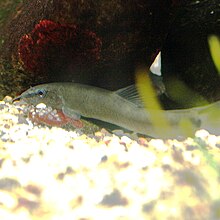Ayumodoki
| Ayumodoki | |
|---|---|

| |
| Scientific classification | |
| Kingdom: | Animalia |
| Phylum: | Chordata |
| Class: | Actinopterygii |
| Order: | Cypriniformes |
| Family: | Botiidae |
| Genus: | Parabotia |
| Species: | P. curtus
|
| Binomial name | |
| Parabotia curtus | |
| Synonyms[2] | |
| |
The Ayumodoki or Kissing Loach (Parabotia curtus) is a species of ray-finned fish in the family Botiidae.[3] It is found in lakes and streams on Honshu, the largest island of Japan.[4] Spawning grounds for kissing loach are ditches and small reservoirs for rice cultivation of a river system located in Japan. The kissing loach migrates to flooded areas, including paddy field areas, for spawning in early summer and the spawning of this species is limited after the formation of flooded areas over terrestrial vegetation.[5] [1] In a study conducted by Tsukasa Abe & Tatsuya Sakamoto they test the early development of kissing loach with special reference to the hatching at the early stage as well as the movement of the larvae toward the water surface. The bottoms of these areas, that are reported to be the spawning grounds for these fishes, are covered with vegetation that are submerged by irrigation water for rice cultivation during the spawning period in early summer. It is at this time "(spawning areas submerged for 39 days in 2005), the water depth at the spawning ground was 54.4 ± 0.4 cm [mean ± standard error (SE); 35 days], and the dissolved oxygen at the bottom and near the water surface (20 cm in depth) was measured at 1800 hours for 35 days with a water quality meter. The bottom water temperature was also measured hourly for 35 days using a data logger with a self-contained thermometer" (Abe & Sakamoto, 2011).<ref>Abe, T., Sakamoto, T. Embryonic development and larval behavior of the kissing loach (Parabotia curta): adaptations to an ephemeral, hypoxic environment. Ichthyol Res 58, 238–244 (2011).
References[]
- ^ Watanabe, K.; Abe, T.; Iwata, A.; Shimizu, T. & Hosoya, K. (2015). "Parabotia curtus". The IUCN Red List of Threatened Species. 2015 (2015). doi:10.2305/IUCN.UK.2015-4.RLTS.T75093504A75094030.en.
- ^ "Synonyms of Parabotia curtus (Temminck & Schlegel, 1846)". Fishbase. Retrieved 19 August 2017.
- ^ Kottelat, M. (2012): Conspectus cobitidum: an inventory of the loaches of the world (Teleostei: Cypriniformes: Cobitoidei). Archived February 11, 2013, at the Wayback Machine The Raffles Bulletin of Zoology, Supplement No. 26: 1-199.
- ^ R. Froese; D. Pauly, eds. (2017). "Parabotia curtus (Temminck & Schlegel, 1846) Kissing loach". Fishbase. Retrieved 19 August 2017.
- ^ Abe, Tsukasa; Sakamoto, Tatsuya (2011). "Embryonic development and larval behavior of the kissing loach (Parabotia curta): adaptations to an ephemeral, hypoxic environment". Ichthyological Research. 58 (3): 238–244. doi:10.1007/s10228-011-0217-3.
- IUCN Red List critically endangered species
- Botiidae
- Natural monuments of Japan
- Cypriniformes stubs
